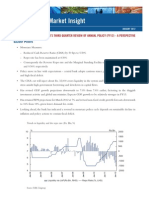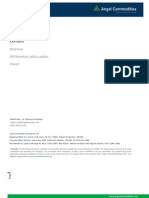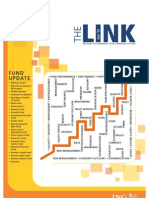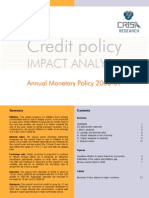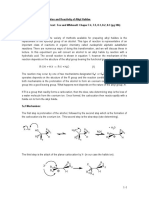FixedIncome January 2012
FixedIncome January 2012
Uploaded by
jayaram_mca83Copyright:
Available Formats
FixedIncome January 2012
FixedIncome January 2012
Uploaded by
jayaram_mca83Original Description:
Copyright
Available Formats
Share this document
Did you find this document useful?
Is this content inappropriate?
Copyright:
Available Formats
FixedIncome January 2012
FixedIncome January 2012
Uploaded by
jayaram_mca83Copyright:
Available Formats
Fixed Income Market View & Outlook
Overview FixedIncomeMarkets Increasing risk to growth, moderating industrial production, decelerating inflation, expected rate reversal by RBI and deteriorating government finances were the key highlights of the month. Globally, improved manufacturing activity, some progress on Eurozone moving closer to fiscal consolidation and continued Greece debt-restructuring problem were the highlights of the month.
Macro Overivew: Global Macro Overview: Downside to global growth risk diminishes, Eurozone moves closer to fiscal consolidation Global Manufacturing Purchasing Managers Index (PMI) in Dec 2011 suggests that the weakness in global manufacturing is starting to diminish. It rose 1.1 points to 50.8 in Dec 2011 - the highest since June 2011. The economic data from US was encouraging as industrial production, housing activity and consumer holiday spending showed signs of improvement. US unemployment rate has also come down. In the recent US Federal Open Market Committee (FOMC) meeting, it was stated that Fed expects to maintain federal funds rate at 0.125% at least through late 2014. In Euro area, the leaders of 25 European Union governments agreed on a historic pact to move closer to fiscal union and signed off on the details of a permanent bailout fund for the euro zone. There was still no clarity on Greece's looming debt restructuring.
India Macro Overview: Increasing risks to growth, moderating inflation, expected rate reversal by RBI and deteriorating Govt of finances In the third quarter policy review on Jan 24th 2012, the RBI cut the cash reserve ratio (CRR) by 50bps to 5.50%, while keeping the key policy interest rates unchanged. RBI had earlier indicated in its October policy review that it is done with its tightening cycle and accordingly maintained status quo in December. It was the first rate cut since RBI started hiking in 2010. A 50 bps CRR cut is expected to release about Rs 32,000 cr of liquidity into the system. Liquidity had been extremely tight recently with banks borrowing to the tune of Rs 120,000 140,000 cr daily from RBI - twice the amount that RBI is comfortable with. Liquidity may remained tight inspite of RBI conducting Open Market Operation (OMO) purchases (buying Gsecs) of around Rs 72,000 cr. It was partially due to forex intervention of RBI in recent months. Also, the upcoming state elections have resulted in increase in currency with public. So, RBI needed to ease the structural pressure in liquidity. A tight liquidity condition, above a threshold, restricts the flow of credit to productive sector harming growth which is anyway slowing. Continued tight liquidity has prompted RBI to restart OMO. Another CRR cut is expected by March 2012. Higher government expenditure, RBI steps and slower credit growth will support liquidity going forward. The central bank revised downward the FY12 GDP estimate to 7% from 7.6% on slower investment, weak industrial production along with global uncertainties. Growth decelerated due to fiscal profligacy combined with monetary tightening, policy paralysis and poor confidence. Growth next fiscal will also remain muted.
February,2012
The RBI remained worried about inflation and retained its March 2012 inflation estimate at 7% despite significant downward revision to growth. The recent fall in WPI to 7.47% yoy in Dec 2011 from 9.11% in Nov 2011 was due to high base and sharp fall in vegetable prices. But the structural supply side issues in protein based food items remained. Inflation is expected to moderate further to around 6.8% to 7% by March 2012 end. There are risks from suppressed inflation as impact of rupee depreciation is yet to be fully felt. Further, if the administered fuel prices are raised after state elections, headline inflation might not come down to RBIs acceptable level even after March 2012. However, inflation next fiscal may be still much lower than this fiscal on aggressive rate hikes, stabilizing global commodity prices and moderation in economic growth. The need for tighter fiscal policy is being talked about for some time now. Fiscal deficit in FY12 may be much higher, as government has already borrowed around Rs 93,000 cr more than budgeted. Fiscal deficit till Dec2011. this fiscal has already reached 92% of budgeted estimate. There may be considerable uncertainty over the fiscal consolidation next year too without any reforms on subsidy. The central government borrowing next year may be around the same, if not a little higher, than this fiscal. One-off gain from expected 2G auction next fiscal might reduce pressure. Fixed Income Overview The bond yields rallied immediately after RBIs CRR cut on Jan 24th 2012 and touched a low of 8.08% but sentiment turned bearish on inflation worry and absence of OMO purchase indication in the policy statement. 10-yr benchmark yield moved back to 8.35%. However, by end of the month, continued liquidity tightness inspite of CRR cut, this may led to announcement of OMO purchases again. Benchmark yields eased to 8.28% as on 31st Jan 2012. The 10-yr G-sec yields had softened 28 bps since end Dec 2011. The 10 year benchmark G-Sec was on an average 8.26%. Corporate bond yields softened taking cues from G-Secs, with 10 year AAA closing the month at 9.30% as against the previous months close of 9.44% and 5 year AAA closed at 9.43% (Previous month: 9.48%). In money market, the CD yields moved up during the month on tight liquidity with 3 months, 6 months and 1 year CDs closed the month at 9.98%, 9.95% and 9.95% as against 9.57%, 9.65% and 9.74% at Dec 2011 end. 1 year Overnight Interest Swaps (OIS) and 5 year OIS were trading at 8.16 % and 7.30% at month end as against 7.75% and 7.10% at end of December 2011. Fixed Income Market Outlook In the policy, the RBI has hinted that the further policy actions will depend on trend in core inflation and governments credible, sustainable fiscal consolidation numbers. Going forward, G-sec market may take cues from OMO auctions, policy makers statements, liquidity scenario and hi-frequency key macroeconomic data points like growth, Wholesale Price Index (WPI),Index of Industrial Production (IIP), credit numbers etc. Global developments like crude oil price, situation in Iran, Euro crisis, Central banks statements and actions will be closely watched. Liquidity in February might ease from previous month on Government expenditure and further OMO by RBI. Yields on short term bonds are expected to remain range-bound. Common Source for Fixed Income View: RBI, Bloomberg, CMIE
February,2012
Disclaimers
The views expressed herein constitute only the opinions and do not constitute any guidelines or recommendation on any course of action to be followed by the reader. This information is meant for general reading purposes only and is not meant to serve as a professional guide for the readers. Certain factual and statistical (both historical and projected) industry and market data and other information was obtained by RCAM from independent, third-party sources that it deems to be reliable, some of which have been cited above. However, RCAM has not independently verified any of such data or other information, or the reasonableness of the assumptions upon which such data and other information was based, and there can be no assurance as to the accuracy of such data and other information. Further, many of the statements and assertions contained in these materials reflect the belief of RCAM, which belief may be based in whole or in part on such data and other information. The Sponsor, the Investment Manager, the Trustee or any of their respective directors, employees, affiliates or representatives do not assume any responsibility for, or warrant the accuracy, completeness, adequacy and reliability of such information. Whilst no action has been solicited based upon the information provided herein, due care has been taken to ensure that the facts are accurate and opinions given are fair and reasonable. This information is not intended to be an offer or solicitation for the purchase or sale of any financial product or instrument. Recipients of this information should rely on information/data arising out of their own investigations. Readers are advised to seek independent professional advice, verify the contents and arrive at an informed investment decision before making any investments. None of the Sponsor, the Investment Manager, the Trustee, their respective directors, employees, affiliates or representatives shall be liable for any direct, indirect, special, incidental, consequential, punitive or exemplary damages, including lost profits arising in any way from the information contained in this material. The Sponsor, the Investment Manager, the Trustee, any of their respective directors, employees including the fund managers, affiliates, representatives including persons involved in the preparation or issuance of this material may from time to time, have long or short positions in, and buy or sell the securities thereof, of company(ies) / specific economic sectors mentioned herein. Statutory Details: Reliance Mutual Fund has been constituted as a trust in accordance with the provisions of the Indian Trusts Act, 1882. Sponsor: Reliance Capital Limited. Trustee: Reliance Capital Trustee Company Limited. Investment Manager: Reliance Capital Asset Management Limited (Registered Office of Trustee & Investment Manager: 'H' Block,1st Floor, Dhirubhai Ambani Knowledge City, Koparkhairne, Navi Mumbai - 400 710, Maharashtra. . The Sponsor, the Trustee and the Investment Manager are incorporated under the Companies Act 1956. The Sponsor is not responsible or liable for any loss resulting from the operation of the Scheme beyond their initial contribution of Rs.1 lakh towards the setting up of the Mutual Fund and such other accretions and additions to the corpus. Risk Factors: Mutual Funds and securities investments are subject to market risks and there is no assurance or guarantee that the objectives of the Scheme will be achieved. As with any investment in securities, the NAV of the Units issued under the Scheme can go up or down depending on the factors and forces affecting the capital markets. The name of the Schemes do not in any manner indicates either the quality of the Scheme; its future prospects or returns. Past performance of the Sponsor/AMC/Mutual Fund is not indicative of the future performance of the Scheme. The NAV of the Scheme may be affected, interalia, by changes in the market conditions, interest rates, trading volumes, settlement periods and transfer procedures. For details of scheme features and for Scheme specific risk factors, please refer to the Scheme Information Document which is available at all the DISC / Distributors / www.reliancemutual.com. Please read the Scheme Information Document and Statement of Additional Information carefully before investing.
February,2012
You might also like
- Standard Documents For Electrical and Mechanical WorksDocument136 pagesStandard Documents For Electrical and Mechanical Worksadnanakhtarhrp100% (2)
- AM No. 04-7-02-SC Guidelines On Corporate Surety BondsDocument24 pagesAM No. 04-7-02-SC Guidelines On Corporate Surety BondsMaria Angelica Rodriguez Alonso100% (2)
- Assignment # 5Document6 pagesAssignment # 5Muqaddas Zulfiqar100% (2)
- Final 2018 QuestionsAndSolutionsDocument37 pagesFinal 2018 QuestionsAndSolutionsLucas X. LiNo ratings yet
- Chemistry Project On Measuring Solubility of Saturated SolutionsDocument14 pagesChemistry Project On Measuring Solubility of Saturated SolutionsNaven Bansal75% (4)
- Market Insight Q3FY12 RBI Policy Review Jan12Document3 pagesMarket Insight Q3FY12 RBI Policy Review Jan12poojarajeswariNo ratings yet
- RBIAnnual Monetary Policy ReviewDocument3 pagesRBIAnnual Monetary Policy ReviewtomydaloorNo ratings yet
- Icici Prudential Mutual Fund Rbi Second Quarter Review of Monetary Policy 2010-11Document4 pagesIcici Prudential Mutual Fund Rbi Second Quarter Review of Monetary Policy 2010-11Vinit KumarNo ratings yet
- Slide - 1: 2009. Between March 2010 and October 2011 The Reserve Bank Raised Its Policy RepoDocument3 pagesSlide - 1: 2009. Between March 2010 and October 2011 The Reserve Bank Raised Its Policy RepoGarrima ParakhNo ratings yet
- Key Highlights:: Inflationary Pressures Overrides Downside Risks To GrowthDocument6 pagesKey Highlights:: Inflationary Pressures Overrides Downside Risks To Growthsamyak_jain_8No ratings yet
- Debt StrategyDocument10 pagesDebt StrategysnehaaggarwalNo ratings yet
- Market Review Future Outlook Feb2012-SbiDocument6 pagesMarket Review Future Outlook Feb2012-SbiSaurav MandhotraNo ratings yet
- Monetary Policy ReviewDocument3 pagesMonetary Policy ReviewNikhil DambalNo ratings yet
- Reserve Bank of India and Its Impact On The Indian Economy Post 1991 (Interest Rates, Exchange Rates and Inflation)Document7 pagesReserve Bank of India and Its Impact On The Indian Economy Post 1991 (Interest Rates, Exchange Rates and Inflation)Mrunal DubeyNo ratings yet
- RBI Monetary Policy ReviewDocument5 pagesRBI Monetary Policy ReviewAngel BrokingNo ratings yet
- C O M P A N Y P R O F I L E: Achal Gupta Managing Director & Chief Executive OfficerDocument61 pagesC O M P A N Y P R O F I L E: Achal Gupta Managing Director & Chief Executive OfficervipinkathpalNo ratings yet
- Monetary Policy May 2011Document13 pagesMonetary Policy May 2011Siddharth VaidNo ratings yet
- RBI Monetary Policy - August 17Document3 pagesRBI Monetary Policy - August 17pappuNo ratings yet
- Fag 3qcy2012ruDocument6 pagesFag 3qcy2012ruAngel BrokingNo ratings yet
- Evolving Bond MarketDocument9 pagesEvolving Bond MarketcoolNo ratings yet
- Indian Financials: Tryst With DestinyDocument28 pagesIndian Financials: Tryst With DestinyJohnny HarlowNo ratings yet
- RBI Monetary Policy UpdateDocument4 pagesRBI Monetary Policy UpdateAngel BrokingNo ratings yet
- INDEPTH - September 2011Document17 pagesINDEPTH - September 2011Vivek BnNo ratings yet
- Mid-Quarter Monetary Policy ReviewDocument3 pagesMid-Quarter Monetary Policy ReviewAngel BrokingNo ratings yet
- Week Ended September 21, 2012: Icici Amc Idfc Amc Icici BankDocument4 pagesWeek Ended September 21, 2012: Icici Amc Idfc Amc Icici BankBonthala BadrNo ratings yet
- Impt. For AsignmentDocument4 pagesImpt. For AsignmentPranshu_Priyad_8742No ratings yet
- RBI Policy Oct 2027Document5 pagesRBI Policy Oct 2027PradeepKanwarNo ratings yet
- Thematic Insights - Welcome 2014Document3 pagesThematic Insights - Welcome 2014Jignesh71No ratings yet
- Helping You Spot Opportunities: Investment Update - October, 2012Document56 pagesHelping You Spot Opportunities: Investment Update - October, 2012Carla TateNo ratings yet
- Strategic Analysis of SBIMFDocument19 pagesStrategic Analysis of SBIMF26amitNo ratings yet
- LinkDocument24 pagesLinkDhileepan KumarasamyNo ratings yet
- Monetary Policy Oct-12Document5 pagesMonetary Policy Oct-12Piyush KhadgiNo ratings yet
- Macro Economics and Business Environment Assignment: Submitted To: Dr. C.S. AdhikariDocument8 pagesMacro Economics and Business Environment Assignment: Submitted To: Dr. C.S. Adhikarigaurav880No ratings yet
- Empower June 2012Document68 pagesEmpower June 2012pravin963No ratings yet
- RBI BulletinDocument118 pagesRBI Bulletintheresa.painter100% (1)
- BIMBSec - Economics - OPR at 4th MPC Meeting 2012 - 20120706Document3 pagesBIMBSec - Economics - OPR at 4th MPC Meeting 2012 - 20120706Bimb SecNo ratings yet
- RBI Raised Interest Rates How This Impacts You!Document5 pagesRBI Raised Interest Rates How This Impacts You!Aishwarya ShettyNo ratings yet
- Q3 RBI Credit Policy ExpectationsDocument3 pagesQ3 RBI Credit Policy ExpectationsRahul SonthaliaNo ratings yet
- RBI S Annual Monetary Policy: RBI Revised Repo Rate and CRR. Policy Expected To Be Aggresive Amid High InflationDocument27 pagesRBI S Annual Monetary Policy: RBI Revised Repo Rate and CRR. Policy Expected To Be Aggresive Amid High Inflationsheetal_sab19929665No ratings yet
- Annual Report For Policy Holders Economic Update20170824 071040Document4 pagesAnnual Report For Policy Holders Economic Update20170824 071040Shree GuruNo ratings yet
- Economy and Finance deDocument5 pagesEconomy and Finance deNischal SolankiNo ratings yet
- Monetary Policy ReviewDocument4 pagesMonetary Policy ReviewiesmcrcNo ratings yet
- WPI Inflation Update - November: Comfort in The Core ComponentDocument5 pagesWPI Inflation Update - November: Comfort in The Core ComponentAngel BrokingNo ratings yet
- Monetary Policy, Inflation and Liquidity Crisis: Bangladesh Economic UpdateDocument17 pagesMonetary Policy, Inflation and Liquidity Crisis: Bangladesh Economic UpdateMuhammad Hasan ParvajNo ratings yet
- The World Economy... - 06/04/2010Document2 pagesThe World Economy... - 06/04/2010Rhb InvestNo ratings yet
- Macro Economic Impact Apr08Document16 pagesMacro Economic Impact Apr08shekhar somaNo ratings yet
- BIMBSec - Economics - OPR at 2nd MPC Meeting 2012 - 20120312Document3 pagesBIMBSec - Economics - OPR at 2nd MPC Meeting 2012 - 20120312Bimb SecNo ratings yet
- RBI Policy June 17Document3 pagesRBI Policy June 17Govind SharmaNo ratings yet
- Monetary Policy Review, 30th January 2013Document5 pagesMonetary Policy Review, 30th January 2013Angel BrokingNo ratings yet
- Monetary PolDocument3 pagesMonetary Polst1dNo ratings yet
- Economic Environment of Business: Group 1Document4 pagesEconomic Environment of Business: Group 1Darshan SankheNo ratings yet
- RBI Monetary Policy UpdateDocument12 pagesRBI Monetary Policy UpdateSai KarthickNo ratings yet
- Initiating Coverage HDFC Bank - 170212Document14 pagesInitiating Coverage HDFC Bank - 170212Sumit JatiaNo ratings yet
- Monthly Market Outlook February 2014Document26 pagesMonthly Market Outlook February 2014Win VitNo ratings yet
- Rbi Credit PolicyDocument8 pagesRbi Credit PolicyamishkanungoNo ratings yet
- Debt Mutual Fund Picks: Macro Data Round UpDocument6 pagesDebt Mutual Fund Picks: Macro Data Round Upnaresh_dayani8459No ratings yet
- RBI MPC Policy '23Document1 pageRBI MPC Policy '23adithyaNo ratings yet
- RBI Springs Surprise, Cuts Repo by 50 Bps by Dinesh Unnikrishnan & Anup RoyDocument5 pagesRBI Springs Surprise, Cuts Repo by 50 Bps by Dinesh Unnikrishnan & Anup RoymahaktripuriNo ratings yet
- Economic Report - 201603Document4 pagesEconomic Report - 201603bajax_lawut9921No ratings yet
- Bond Market Perspectives: The Yield Ascent ResumesDocument3 pagesBond Market Perspectives: The Yield Ascent Resumesapi-234126528No ratings yet
- Asset Quality: That Sinking Feeling!Document33 pagesAsset Quality: That Sinking Feeling!Ronitsinghthakur SinghNo ratings yet
- Monetary Policy Note - October 2024Document3 pagesMonetary Policy Note - October 2024abhaykumarmittal001No ratings yet
- Asian Development Outlook 2015: Financing Asia’s Future GrowthFrom EverandAsian Development Outlook 2015: Financing Asia’s Future GrowthNo ratings yet
- Requirements Phase Defects Checklist - (Sample Checklist) : Check Mark The Appropriate Column Yes N/ADocument1 pageRequirements Phase Defects Checklist - (Sample Checklist) : Check Mark The Appropriate Column Yes N/Ajayaram_mca83No ratings yet
- The Java Virtual Machine: Heap ManagementDocument9 pagesThe Java Virtual Machine: Heap Managementjayaram_mca83No ratings yet
- Mobile Banking Fact SheetDocument8 pagesMobile Banking Fact Sheetjayaram_mca83No ratings yet
- WWW Snaq Net Java DBPoolDocument33 pagesWWW Snaq Net Java DBPooljayaram_mca83No ratings yet
- Mobile Banking Fact SheetDocument8 pagesMobile Banking Fact Sheetjayaram_mca83No ratings yet
- Blackanvil Blogspot in 2006 06 Shootout Load Runner Vs GrindDocument33 pagesBlackanvil Blogspot in 2006 06 Shootout Load Runner Vs Grindjayaram_mca83No ratings yet
- ValueResearchFundcard QuantumLongTermEquity 2011jan06Document6 pagesValueResearchFundcard QuantumLongTermEquity 2011jan06jayaram_mca83No ratings yet
- Translation-An Overview: Professor (DR.) Namrata Chhabra Biochemistry For Medics - Lecture Notes WWW - Namrata.coDocument32 pagesTranslation-An Overview: Professor (DR.) Namrata Chhabra Biochemistry For Medics - Lecture Notes WWW - Namrata.coDurga Charan PradhanNo ratings yet
- Ramamurthy, Chem Rev, 1987, Photochemical Reactions in Organic CrystalsDocument49 pagesRamamurthy, Chem Rev, 1987, Photochemical Reactions in Organic CrystalsKonkmanNo ratings yet
- Audit Fot Liability Problem #10Document2 pagesAudit Fot Liability Problem #10Ma Teresa B. CerezoNo ratings yet
- Assignment 1 Business & FinanceDocument4 pagesAssignment 1 Business & FinanceSan Lizas AirenNo ratings yet
- Laboratory 1 - Alkyl HalidesDocument7 pagesLaboratory 1 - Alkyl Halidessindhsanam100% (1)
- Bloomberg FunctionsDocument1 pageBloomberg Functionschandra_kumarbrNo ratings yet
- CARBOHYDRATESDocument38 pagesCARBOHYDRATESgulrukh100% (3)
- Mock Exam - Section ADocument4 pagesMock Exam - Section AHAHAHANo ratings yet
- Born Haber Cycle TeacherDocument13 pagesBorn Haber Cycle TeacherLalith77No ratings yet
- CHP 6 Class Review ChemDocument15 pagesCHP 6 Class Review ChemNatalie RussellNo ratings yet
- Investment AvenuesDocument35 pagesInvestment AvenuesJoshua Stalin SelvarajNo ratings yet
- Solids Liquids SolutionsDocument18 pagesSolids Liquids SolutionsZaheer MohiuddinNo ratings yet
- 1 Solution Assignment 1Document4 pages1 Solution Assignment 1No NoNo ratings yet
- Reaction of Alkenes and Alkynes For StudentsDocument53 pagesReaction of Alkenes and Alkynes For StudentsGlen MangaliNo ratings yet
- Chapter 2 Funtional Group PropertiesDocument38 pagesChapter 2 Funtional Group Properties伟铭100% (1)
- AlkunaDocument41 pagesAlkunaAlfaiz Radea ArbiandaNo ratings yet
- Everything You Need To Know About BondsDocument9 pagesEverything You Need To Know About BondszhengyiilpavNo ratings yet
- Special Proceeding OutlineDocument2 pagesSpecial Proceeding OutlineJesa BayonetaNo ratings yet
- Nomenclature HandoutDocument4 pagesNomenclature Handoutapi-292528253No ratings yet
- CH 21Document44 pagesCH 21nonfiction0667% (3)
- Market Review & Outlook by Meridian Asset Management SDN BHDDocument35 pagesMarket Review & Outlook by Meridian Asset Management SDN BHDMohd RasidNo ratings yet
- A Brief Note On DebenturesDocument4 pagesA Brief Note On DebenturesSandeep SinghNo ratings yet
- 4 - Chemical Reactions & EquilibriumDocument20 pages4 - Chemical Reactions & Equilibriumsirsa11No ratings yet
- Carbohydrate NomenclatureDocument4 pagesCarbohydrate NomenclaturekiwicronzNo ratings yet
- PP Questionnaire OnlyDocument15 pagesPP Questionnaire OnlyVholts Villa VitugNo ratings yet





